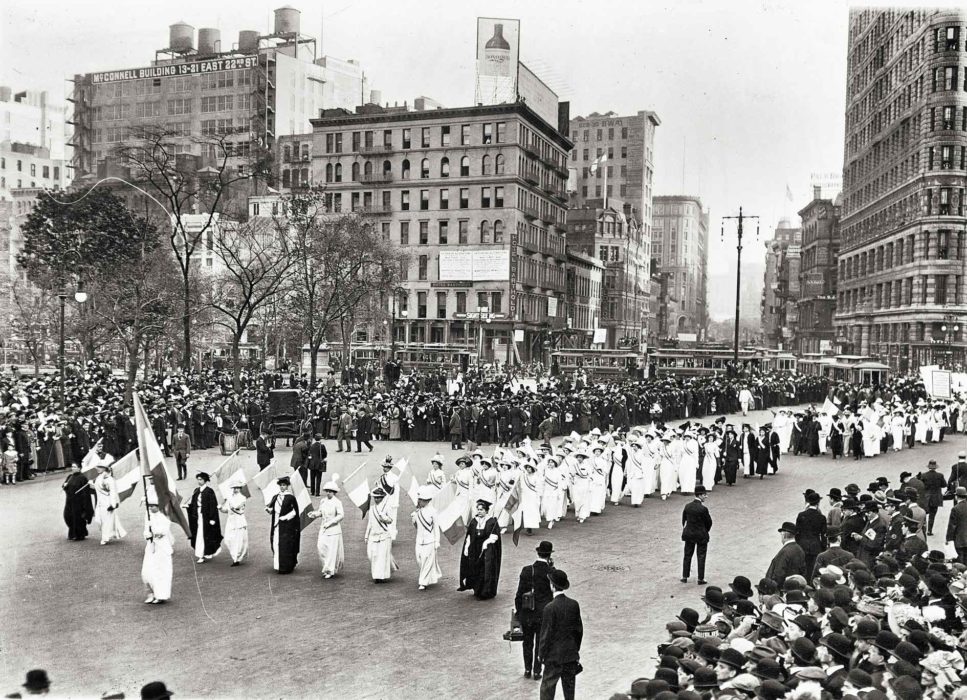JOAN OF ARC’s SILVER suit shone in the afternoon sun. You wouldn’t have been able to hear her horse’s hooves on the pavement, because on every side traffic officers blew their whistles, marching bands played, and cheers rose from the crowds clogging every inch along the sidewalks.
The women’s suffrage march in New York had taken place two weeks ago, on May 4, 1912, while ‘Abdu’l-Bahá was in Chicago. At five o’clock sharp, an army began to march up Fifth Avenue from Washington Square. There were 10,000 of them, including 838 men. It was a parade “the like of which New York never knew before,” the New York Times said. Nearly half a million people had emptied the surrounding buildings to look on.
Today, on May 20th, ‘Abdu’l-Bahá was standing in front of a suffrage meeting beneath the huge McKinley Memorial Organ at the Metropolitan Temple, on Seventh Avenue at 14th Street in New York. “Universal Peace is impossible without Universal Suffrage,” he said. “It has been objected by some that woman is not equally capable with man and that she is by creation deficient. This is pure imagination. The difference which exists between man and woman is a difference due solely to education.”

“It will come to pass that when womankind partake fully and equally in the affairs of the world—in the great arena of laws and politics—war will cease; for woman will prove the obstacle and hindrance to it.”
Women on horseback trotted around the eastern flank of the Washington Arch. Most of the riders wore black suffrage hats, three-cornered headpieces made of rough straw and adorned with a tricolor cockade in purple, green, and white. Marie Stewart was the one dressed as Joan of Arc, riding a milk-white horse. Behind her 100 women carried painted green soapboxes. Instead of handing out literature to the spectators, and leaving a trail of discarded paper all along Fifth Avenue, they were going to place themselves strategically among the crowd, mount their soapboxes, and speak in support of the vote.
Mrs. Harriet Stanton Blatch, of Seneca Falls, NY, was the chief organizer of the march. Her mother, Elizabeth Cady Stanton, had drafted the Declaration of Sentiments at the Seneca Falls Women’s Rights Convention in 1848, and launched the suffrage movement. Mrs. Blatch’s “Final Word to Marchers” had been printed the day before: “March with head erect,” she told the women. “Eyes to the front. Remember, you march for the mightiest reform the world has ever seen.”
“In past ages,” ‘Abdu’l-Bahá told his audience, “noted women have arisen in the affairs of nations and surpassed men in their accomplishments. Among them was Zenobia, Queen of the East, whose capital was Palmyra . . . . She conquered Syria, subdued Egypt and founded a most wonderful kingdom with the utmost skill and thoroughness.”
As the first of the marchers left the square, more filed in behind them. Miss Alberta Hill’s contingent joined the army at the north edge of Washington Square. She had been in Albany trying to convince unwilling state senators to support the women’s vote. Regiments of professional women—doctors, lawyers, writers, musicians, artists, librarians, lecturers, and social workers—merged at East 9th Street. They met 2,000 industrial workers coming the other way on 9th—milliners, dressmakers, shirtwaist makers, laundresses, and domestic workers. Businesswomen swelled the ranks one block up: managers, buyers, tea room proprietors, secretaries, bookkeepers, stenographers, and telephone operators. The suffrage pioneers joined the marching masses at the corner where the Church of the Ascension stood at Fifth Avenue and 10th Street. The Reverend Antoinette Brown Blackwell, America’s first ordained female minister, rode in an open victoria covered in lilacs and dogwood blossoms, attached to horses sporting yellow plumes and a driver in yellow and black livery. At eighty-six Reverend Blackwell was the oldest living suffragist. Little John Gillespie was the youngest one in the march: he was just fourteen months old, riding in a wicker go-cart and shaking his rattle.
“The Roman Empire sent a great army against her,” ‘Abdu’l-Bahá said. “When this army replete with the finest military tactics reached Syria, Zenobia, herself appeared upon the field leading her soldiers. On the day of battle she bedecked herself in variegated garments, placed a crown upon her head, mounted a horse and rode forth sword in hand. . . .”
Mr. Frederick S. Greene, leader of the men’s division in the parade, said that last year, in 1911, they had marched “amid a storm of hissing and missiles.” His group had a wet towel hurled at them from a window opposite the Waldorf. But this year things were different. Inspector McClusky, the head of the NYPD’s detective bureau, thought so, too. “It’s about time to give them the vote,” he said, tightening his belt at 23rd Street, “I wish to God they would. I’d be with ‘em.”
Zenobia destroyed the Roman army. Finally the Emperor Aurelian marched into Syria himself with 200,000 men. He besieged Palmyra for two years, eventually cutting off the city’s water supply. Faced with her people’s starvation, Zenobia was forced to surrender.
Aurelian marched her into Rome with a golden chain around her neck. A procession of elephants, lions, tigers, and monkeys preceded her, and on her head she wore a crown. “Verily, I glory in being a woman and in having withstood the Roman Empire,” she told the crowd with queenly dignity. “And this chain about my neck is therefore not a sign of humiliation but of glorification.”
“This is a symbol of my power,” she said, “not of my defeat.”

As the afternoon gave way to evening the women lit torches, a river of fire flowing north toward Central Park. By the time the sun began to set, the last of the marchers were reaching the end. Regiment by regiment they joined the others, cramming the intersections around Carnegie Hall.
Joan of Arc dismounted her horse and vanished into the crowd.






